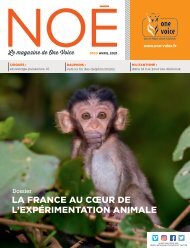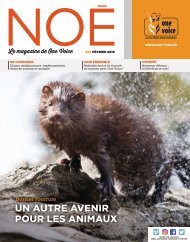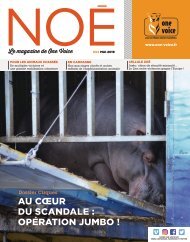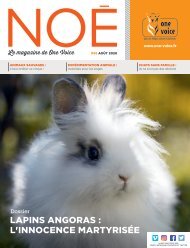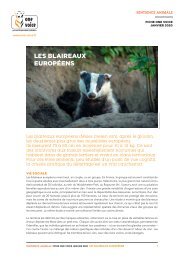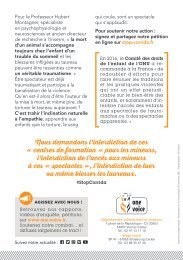The replacement of non human primates in brain research
You also want an ePaper? Increase the reach of your titles
YUMPU automatically turns print PDFs into web optimized ePapers that Google loves.
Park<strong>in</strong>son’s disease<br />
Park<strong>in</strong>son’s disease is a degenerative disorder <strong>of</strong> the central nervous system that affects movement,<br />
speech and other functions. It is characterised by muscle tremors and a progressive slow<strong>in</strong>g <strong>of</strong><br />
physical movement as a result <strong>of</strong> <strong>in</strong>sufficient bra<strong>in</strong> chemical called dopam<strong>in</strong>e. Among the<br />
environmental causes <strong>of</strong> this disease is exposure to pesticides. Although no cure exists at present the<br />
use <strong>of</strong> L-DOPA is the treatment <strong>of</strong> choice. However, as the usefulness <strong>of</strong> this treatment decreases over<br />
time, other treatments may be employed, such as deep bra<strong>in</strong> stimulation.<br />
Accord<strong>in</strong>g to neurosurgeon Marius Maxwell, “<strong>The</strong> “<strong>of</strong>ficial” and highly selective primate<br />
vivisection-based narrative <strong>of</strong> deep bra<strong>in</strong> stimulation mislead<strong>in</strong>gly beg<strong>in</strong>s with the serendipitous<br />
discovery <strong>of</strong> symptoms <strong>of</strong> park<strong>in</strong>sonism <strong>in</strong> young drug addicts exposed to the narcotic contam<strong>in</strong>ant<br />
MPTP (1-methyl-4-phenyl-1,2,3,6-tetrahydropyrid<strong>in</strong>e). This gave <strong>research</strong>ers the idea <strong>of</strong> see<strong>in</strong>g<br />
whether monkeys would also display Park<strong>in</strong>sonian symptoms <strong>in</strong> response to this tox<strong>in</strong> and <strong>in</strong>deed,<br />
<strong>in</strong> 1983 monkeys poisoned with MPTP were found to exhibit similar, albeit temporary, symptoms<br />
and the <strong>non</strong>-<strong>human</strong> primate model <strong>of</strong> park<strong>in</strong>sonism was born (Burns et al. 1983).<br />
All well and good, it seems. <strong>The</strong> general public is served a compell<strong>in</strong>g tale <strong>of</strong> successful medical<br />
<strong>research</strong> borne on the back <strong>of</strong> primate misery and has come to believe that <strong>human</strong> sufferers <strong>of</strong> the<br />
ravages <strong>of</strong> Park<strong>in</strong>son’s disease have been treated thanks to cutt<strong>in</strong>g-edge <strong>research</strong> performed on our<br />
close primate cous<strong>in</strong>s.<br />
But what will they say when they f<strong>in</strong>d out that the importance <strong>of</strong> the subthalamic nucleus to the<br />
treatment <strong>of</strong> Park<strong>in</strong>son’s disease had <strong>in</strong> fact been known more than 30 years before by<br />
neurosurgeons who employed this knowledge to successfully treat hundreds <strong>of</strong> <strong>human</strong> patients? How<br />
will they react when they discover that deep bra<strong>in</strong> stimulation has been used s<strong>in</strong>ce the 1940s, and<br />
that early implanted stimulators were used <strong>in</strong> <strong>human</strong> patients with Park<strong>in</strong>son’s and other movement<br />
disorders years before the first ever description <strong>of</strong> the MPTP-primate model?<br />
This discovery and use <strong>of</strong> deep bra<strong>in</strong> stimulation therefore predates the very first description <strong>of</strong> the<br />
MPTP-primate model <strong>of</strong> Park<strong>in</strong>son’s disease by nearly 40 years! As we shall see, deep bra<strong>in</strong><br />
stimulation would not realise its full potential until 1980 when a fully implantable and reversible<br />
stimulator system for movement disorders was developed, this still a full three years before the<br />
Park<strong>in</strong>son’s disease MPTP-primate model was even first described.” (24).<br />
We live today <strong>in</strong> an era <strong>of</strong> evidence based medic<strong>in</strong>e. Many medical treatments developed through<br />
animal experiments and considered to be “standard therapy” have subsequently been discont<strong>in</strong>ued<br />
follow<strong>in</strong>g careful comparison <strong>of</strong> treatment outcomes between large numbers <strong>of</strong> treated and untreated<br />
patients. <strong>The</strong> same is true for deep bra<strong>in</strong> stimulation (which is not without its risks and complications).<br />
<strong>The</strong>re is very little reliable evidence available as to the efficacy <strong>of</strong> deep bra<strong>in</strong> stimulation. Few<br />
randomised trials have addressed this question, which is why the University Of Birm<strong>in</strong>gham (UK) has<br />
undertaken the first large randomised trials to study the overall outcome <strong>of</strong> surgery for Park<strong>in</strong>son’s<br />
Disease. It is important to note that this study will <strong>in</strong>volve only <strong>human</strong> patients and not animals. <strong>The</strong><br />
results <strong>of</strong> this study will be published once they have been fully analysed (25).<br />
14<br />
One Voice • <strong>The</strong> <strong>replacement</strong> <strong>of</strong> <strong>non</strong> <strong>human</strong> <strong>primates</strong> <strong>in</strong> bra<strong>in</strong> <strong>research</strong>



